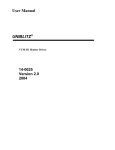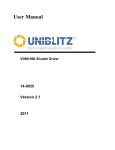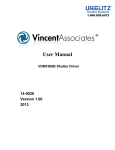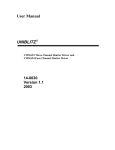Download INSTRUCTION MANUAL - Vincent Associates
Transcript
1.800.828.6972 User Manual D880C Constant Current Shutter Driver 14-0010 Version 2.00 2013 For information regarding applicable intellectual property, please visit www.uniblitz.com/patents. Information in this publication supersedes that in all previously published material. Due to our ongoing development program, Vincent Associates reserves the right to discontinue or change specifications or designs, at any time, without incurring any obligation. Version 2.00 2013 Vincent Associates, a Division of VA, Inc. 803 Linden Ave. Rochester, NY 14625 Tel: 585-385-5930 Fax: 585-385-6004 UNIBLITZ®, N-CAS® and VINCENT ASSOCIATES® are registered trademarks of VA, Inc. Printed in the U.S.A. D880C User Manual 1 Warranty LIMITED PRODUCT WARRANTY: All Products manufactured by VINCENT ASSOCIATES® (MANUFACTURER) are warranted to meet published specifications and to be free of defects in materials and workmanship as defined in the specifications for 365 days - one year - (WARRANTY PERIOD) from the date of original shipment of the product. DSS series shutters are additionally warranted to achieve two million cycles within the WARRANTY PERIOD (as defined in the CYCLE WARRANTY CRITERION). MANUFACTURER will, at its own option within the WARRANTY PERIOD, repair or replace without charge any listed item discovered to be defective excepting transportation charges. Burned out or otherwise damaged actuator coils are not covered under this warranty. Any defective product returned to the MANUFACTURER must follow the RETURN MATERIAL AUTHORIZATION PROCEDURE as defined below. This warranty does not extend to cover damage resulting from alteration, misuse, negligence, abuse, normal wear and tear, or accident. The MANUFACTURER will consider the return of unused equipment if returned within 30 days from the original date of shipment, subject to a 20% restocking charge. This offer does not apply to used or damaged equipment. This warranty extends only to the original purchase and is not available to any third party, including any purchaser assemblies or other Products of which the goods may become component equipment. CYCLE WARRANTY CRITERION: One "cycle" is considered one open and one closure of the shutter. DSS Shutter must be operated with the ED12DSS driver or equivalent H-Bridge type shutter driver circuit at +10.7VDC across the actuator coil for the specified duration. DSS Shutter must be operated within the defined environmental, electrical and mechanical specifications as listed on the device's data sheet. After one year (WARRANTY PERIOD), the cycle warranty is null and void. If returned, the device must be accompanied by a written statement indicating the approximate number of cycles contained on the device, include all parameters to which the shutter was operated and follow the RETURN MATERIAL AUTHORIZATION PROCEDURE as defined below. RETURN MATERIAL AUTHORIZATION PROCEDURE: MANUFACTURER will only accept returned Products from customers that have obtained an RMA (Return Material Authorization) number from the MANUFACTURER. The customer must also include an itemized statement of defect(s). The Product will then be evaluated per the MANUFACTURER'S standard repair guidelines. Any Product which has been returned to the MANUFACTURER but which is found to meet the applicable specifications and not defective in materials and workmanship shall be subject to the MANUFACTURER's standard evaluation charge. The MANUFACTURER assumes no liability for customer returned material. LIMIT OF LIABILITY: The buyer's exclusive remedy and the limit of MANUFACTURER'S liability for any loss whatsoever shall not exceed the purchase price paid by the buyer for the goods to which a claim is made. MANUFACTURER does not give any implied warranties of merchantability, fitness for a particular purpose, or of any other nature in connection with the sale of any Products. D880C User Manual 2 Table of Contents WARRANTY ............................................................................................................ 2 TABLE OF CONTENTS ........................................................................................ 3 LIST OF FIGURES ................................................................................................. 4 LIST OF TABLES ................................................................................................... 4 GENERAL SAFETY SUMMARY ......................................................................... 5 Injury Precautions ..................................................................................................................... 5 Product Damage Precautions ................................................................................................... 5 Safety Terms and Symbols........................................................................................................ 6 INTRODUCTION.................................................................................................... 7 D880C FEATURES ................................................................................................. 8 OPERATING INSTRUCTIONS ............................................................................ 9 Operation .................................................................................................................................... 9 Power Supply Connection ....................................................................................................... 10 Triggering Methods ................................................................................................................. 10 Miscellaneous ........................................................................................................................... 11 Repeat Exposures ................................................................................................................. 11 Multiple Simultaneous Shutter Operation ......................................................................... 11 Synchronization .................................................................................................................... 11 External Low Voltage Power Supply Input (Optional) .................................................... 11 Model 710P Cable Layout ................................................................................................... 12 Maintenance ............................................................................................................................. 13 SPECIFICATIONS................................................................................................15 D880C System Characteristics ............................................................................................... 15 D880C External Input Characteristics .................................................................................. 16 D880C External Output Characteristics ............................................................................... 17 D880C General Characteristics .............................................................................................. 18 D880C DIAGRAMS...............................................................................................20 INDEX .....................................................................................................................23 D880C User Manual 3 List of Figures Figure 1: D880C Control Diagram ............................................................................................ 20 Figure 2: D880C Jumper Location and Layout ....................................................................... 21 Figure 3: D880C Printed Circuit Board Outline Diagram ..................................................... 22 List of Tables Table 1: 710P Cable Layout for the D880C.............................................................................. 12 D880C User Manual 4 General Safety Summary Review the following safety precautions to avoid injury and prevent damage to this product or any products connected to it. To avoid potential hazards, use the product only as specified. Only qualified personnel should perform service procedures. Injury Precautions Avoid Electric Overload – To avoid electrical shock or fire hazard, do not apply a voltage to a terminal that is outside the range specified for that terminal. Avoid Electric Shock – To avoid injury or loss of life, do not work on or near unit while it is connected to the DC power source. Ground the Product –Before making connections to the input or output terminals of the product, ensure that the product is properly grounded. DO NOT DEFEAT THE GROUND CONNECTION. Do Not operate in Wet/Damp Conditions – To avoid electric shock, do not operate this product in wet or damp conditions. Do Not Operate in an Explosive Atmosphere – To avoid injury or fire hazard, do not operate this product in an explosive atmosphere. Product Damage Precautions Use Proper Power Source – Do not operate this product from a power source that applies more than the voltage specified. Provide Proper Ventilation – To prevent product overheating, provide proper ventilation. Do Not Operate with Suspected Failures – If you suspect there is damage to this product, have it inspected by qualified service personnel. D880C User Manual 5 Safety Terms and Symbols These terms appear in this manual: WARNING Warning statements identify conditions or practices that could result in injury or loss of life. CAUTION Caution statements identify conditions or practices that could result in damage to this product or other property. D880C User Manual 6 Introduction The D880C is the most advanced drive system available for UNIBLITZ™ shutter units. Its unique design has proven in test after test to provide shutter systems (specified with an "E" designation) an operational life cycle count which exceeds that of the standard capacitive discharge driver. Shutters using this driver type will operate with an extended opening duration due to the reduced pulse voltage amplitude. The versatility of the D880C allows it to operate all apertures in the UNIBLITZ™ line. Dwell time is only limited to the shutter's mechanical ability and not to the charge of a capacitor. A shutter will now operate at different frequencies without a change in rise time. The user can now take complete advantage of the shutter's < 2% repeatability from exposure to exposure, no longer limited by dwell time. The D880C, as with all of our shutter drivers, provides a low voltage output that allows a number of different external triggering methods. This, in addition to the pluggable input/output connector, gives the user a distinct benefit when implementing the unit into a specific application. Please read the entire manual carefully before attempting to operate the unit. D880C User Manual 7 D880C Features Open-frame printed circuit card suitable for OEM applications. RoHS compliant. Operates CS, LS, VS or XRS series shutters. 12-pole pluggable I/O terminal strip connector for wire termination. 710P shutter interconnect cable included. Exposure determined by external pulse source for pulse width determined exposure time. Operates from user-supplied +24 VDC power supply. Employing a proprietary drive system in conjunction with the "E" designation provides a shutter lifetime which can meet or exceed as many as 5 million operations Can be factory adjusted for specific pulse current duration. Small size allows the unit to be integrated into many space-critical OEM applications. D880C Dimensions: 1.0 x 3.2 x 4.0 inches (2.54 x 8.12 x 10.16 cm) D880C User Manual 8 Operating Instructions Operation CAUTION Be sure to observe Electro-Static Discharge (ESD) anti-static unpacking and handling procedures at all times when handling the D880C. Improper handling can result in destruction of the CMOS integrated circuits located on the board surface. The D880C provides the circuitry necessary to efficiently drive UNIBLITZ™ shutter units. By providing the unit with the correct initiating control signal, the shutter can be made to open and close on command. The circuitry is precisely matched to provide UNIBLITZ™ shutters a life time which can meet or exceed as many as 5 million operations? Prior to the connection of input/output signals to the D880C, remove the pluggable I/O connector (P1) from the printed circuit board unit and set printed circuit board unit aside. The P1 connector can be removed by grasping hold of both sides and pulling it away from the printed circuit board. A slight rocking motion from side to side will aid in the plug's removal. Make all connections to P1 connector plug prior to mating it with the printed circuit board unit. Typical connections will include a +24 VDC power supply and the user specified shutter unit. Additional connections will be determined by the type of triggering needed for your particular application. See Figure 1 to determine your particular controlling method. Reference Figures 2 and 3, respectively, for proper connections to D880C. D880C User Manual 9 Power Supply Connection Connect the power supply as follows: CAUTION Failure to connect the power supply properly will result in damage to the D880C and/or power supply. 1. Connect the (+) positive wire (RED) of the supply to PIN #1 of terminal strip P1. 2. Connect the (-) return wire (BLACK) and ground wire (GREEN) of the power supply to PIN #2 of P1. Triggering Methods Determine the method of triggering to be used. Please refer to Figure 1, it shows three typical methods of triggering the D880C. Simple Switch Contact Closure: Connect a switch or relay contact as shown in Figure 1. The shutter will open and remain open for as long as the switch is in the closed position. External Pulse Source: A pulse source can be provided from: - Pulse generator - Single bit from a computer parallel port - Any equivalent pulse source. A common ground must be maintained. By connecting a pulse source as shown in Figure 1, the shutter will remain open as long as the pulse remains in the high state. When using this method of control, be sure to note the Minimum Exposure Time (MET) of the shutter. If the pulse width input is less than the MET, the shutter may only open partially or not at all. This is true for all triggering methods. Transistor Switch Closure: Similar to the mechanical switch closure except the correct polarity must be maintained and all grounds must be common. When using the NPN type or an equivalent type of transistor shown, such as an opto-isolator, the collector lead of the transistor must be connected to the +6.75VDC (PIN 4) of the D880C and the emitter lead must be connected to the trigger input (PIN 10). Also be sure that the driving circuit ground is connected to the ground (PIN 11) of the D880C. If using an equivalent transistor type the maximum input current is 1 mA. D880C User Manual 10 Miscellaneous Repeat Exposures The repeat exposure specification listed in this manual is limited by the type of shutter used. At higher frequencies (above 10 Hz) heat can build up in the shutter coil especially if the shutter is subject to limited air flow. This can cause premature failure. Please contact the factory for specific information concerning shutter modifications and/or drive modifications that may be necessary to operate shutters at their maximum frequency. Please also note that the shutter outputs are NOT fuse protected. This protection must be provided by the user. Contact the factory for further details regarding specific fuse selection. CAUTION Please note that the D880C drive unit is capable of driving only one shutter. Attempting to drive multiple shutters will damage the D880C drive unit and/or shutter. This can also overload the power and/or the shutters may not operate to published specifications. Multiple Simultaneous Shutter Operation Under certain circumstances multiple D880C drive units can be operated from one power supply. If the user’s requirements do not necessitate shutters to open simultaneously, two drivers may be operated from one supply. It would be advisable to discuss the particular application with one of our technical support representatives. Synchronization The D880C can be used to operate the Electronic Synchronization system if the Electronic Sync option is available with the selected shutter. The Electronic Sync will provide a signal directly from the shutter mechanism through the D880C controller. Please see Figure 3. When the shutter opens to 90% of full aperture the electronic Sync Output (Pin 12) will provide > 3.5VDC with the shutter in the open position (Logic 1), and < 0.5VDC with the shutter closed (Logic 0). External Low Voltage Power Supply Input (Optional) The D880C derives its shutter hold voltage from the +24VDC power supply via an on board step-down switching regulator operating at 52 KHz. If this switching frequency will interfere with the user application, the on board regulator can be disabled. To disable the on board regulator, remove shunt JP1 and place it at JP2. This changes Pin 9 from a ground terminal to a +7.4VDC input and disables the on board regulator, supplies low voltage bias to the circuit, and provides the shutter hold current. The external supply used must be capable of supplying at least 600 mA for proper operation. D880C User Manual 11 Model 710P Cable Layout The table below shows the layout of the 710P cable supplied with the D880C. 7-Pin WPI Female Connector A B C D E F H Function Shutter Coil Shutter Coil Sync Control Ground (circuit) Sync Control +6.75VDC Ground (shutter) 710P Wire Color Red Black White Green Orange Blue Brown D880C Pin Number 7 8 3 6 5 4 9 Table 1: 710P Cable Layout for the D880C D880C User Manual 12 Maintenance CAUTION Be sure to observe Electro-Static Discharge (ESD) anti-static unpacking and handling procedures at all times when handling the D880C. Improper handling can result in destruction of the CMOS integrated circuits located on the board surface. There are no user-serviceable parts on the D880C. Observe proper handling, care and maintenance of the D880C. It is a sensitive electronic instrument. Although the stability of the drive voltage is checked and calibrated prior to shipment, it may become necessary to make some minor adjustments to the operating systems of the D880C over time. It is highly recommended that if a problem is suspected with the unit that it be returned to the factory for checkout, proper adjustments and calibration. Failure to do this may damage the unit’s circuitry and/or functionality and will void the factory warranty. D880C User Manual 13 NOTES D880C User Manual 14 Specifications D880C System Characteristics Name Repeat Exposure Description Minimum time between exposures is determined by shutter used. Continuously variable exposure frequency from DC to the shutter’s maximum rate. Shutter Drive Pulse Current: 1.2 A Hold Current: 300 mA +24 VDC regulated ±2% Power Supply 1.5 A, minimum User Supplied D880C User Manual 15 D880C External Input Characteristics Name Signal Input P1 Pin 10 Function Input impedance Max. input voltage Min input voltage necessary to ensure triggering Nominal input trigger voltage Min pulse width Max. pulse width Input signals Power Requirements External Low Voltage Input (Note: Remove shunt from JP2 Pins 1 & 2, move to JP2 Pins 3 & 4 to activate this input) Sync Control D880C User Manual 1 9 5 Operating a shutter to max frequency response (determined by shutter used). Single exposures or for low frequency requirements External shutter hold Electronic Synchronization System Description 20 K ohms +20 VDC (100% duty cycle). +1.5 VDC +5 VDC logic signal (TTL or CMOS) Determined by shutter used Determined by exposure time desired Can be provided from most pulse sources or from mechanical/electronic switch contact closures +24 VDC/1.5 ADC 1.5 ADC/50ms +7.4 VDC/600 mA DC Will also disable on board switching regulator (Note: with shunt in JP2 Pins 1 & 2, Pin 9 is a ground point. Be sure that two shunts are not in at the same time.) Connects to detector of shutter’s synchronization sensor (if so equipped). 16 D880C External Output Characteristics Name Pin Function Description 7 Shutter (A) Send Proprietary output signal. Provides for extended shutter life. 8 Shutter (B) Return Output will follow input signal Low Voltage Supply Output 4 Remote switching/external circuit bias Electronic Sync Out 12 Output for shutter equipped with electronic sync Sync Control 3 Electronic Synchronization System +6.75VDC at 50mA available to the user for use in remote switching into signal input and for external circuit biasing. Provides output for shutter equipped with electronic sync. System. <0.5VDC when the shutter is deactivated >3.5VDC when the shutter is activated. Active-high or active-low selection by Jumper JP3. Connects to emitter of shutter’s synchronization sensor (if so equipped) Shutter Output D880C User Manual 17 D880C General Characteristics Name Description Size (HWD) 1.0 x 3.2 x 4.0 inches (2.54 x 8.12 x 10.16 cm) Weight 3 oz.(.09 kg) Input/Output Connector 12 pole in-line pluggable terminal strip. Wire size - 12AWG max P1 Connections Pin 1 Input +24 VDC (Regulated) Pin 2 Passive Power Ground Pin 3 Output Sync control; White wire 710P Pin 4 Output +6.75 VDC (Regulated); Blue wire of 710P Pin 5 Input Sync control; Orange wire of 710P Pin 6 Passive Sync Ground; Green wire of 710P Pin 7 Output Shutter (A); Red wire of 710P Pin 8 Output Shutter (B); Black wire of 710P Pin 9 Passive Ground when shunt in JP2 Pins 1,2; Brown wire of 710P Pin 9 Input 7.4 VDC (600 mA) input when shunt in JP2 Pins 3,4 Pin 10 Input Trigger input Pin 11 Passive Signal Ground Pin 12 Output Electronic sync output Notes: 1. P1 connections: Proper JP1 selection must be made for proper shutter operation. Please see JUMPER SELECTIONS, below. 2. Pins 3,4,5,6: Used only when shutter is equipped with electronic sync. 3. Pin 9: Used for shutter frame grounding or external low D880C User Manual 18 voltage input, jumper selectable. 4. Pin 12: Active-high or active-low output when electronic sync is activated, jumper selectable. 5. Pin 10: Trigger input: Minimum voltage 1.5 VDC, maximum voltage 20 VDC, active-high only. 6. P1 plug is removable. Jumper Selections JP1 Pin 1, 2 LS2 Shutter (Please refer to Figure 2) Pin 3, 4 LS3/LS6 Shutter Pin 5, 6 VS14 Shutter Pin 7, 8 VS25/CS25 Shutter Pin 9, 10 VS35/CS35 Shutter Pin 11, 12 CS45/CS65 Shutter Pin 13, 14 Adjustable For Special Device Pin 1, 2 Pin 9 Is Ground Pin 3, 4 Pin 9 Is 7.4 VDC (600 mA) Input; On-Board Step Down Switching Regulator Is Disabled. JP3 Pin 1, 2 Sync Output Is Active-High (Please refer to Figure 2) Pin 3, 4 Sync Output Is Active-Low JP2 (Please refer to Figure 2) D880C User Manual 19 D880C Diagrams Figure 1: D880C Control Diagram D880C User Manual 20 Figure 2: D880C Jumper Location and Layout D880C User Manual 21 Figure 3: D880C Printed Circuit Board Outline Diagram D880C User Manual 22 Index +24 VDC, 8, 9 710P, 8, 12 710P Cable Layout, 12 calibration, 13 collector, 10 Control Diagram, 20 CS series shutters, 8 CS25, 19 CS35, 19 CS45, 19 CS65, 19 D880C, 7 Diagrams, 20 Dimensions, 8 drive voltage, 13 Dwell time, 7 Electric Overload, 5 Electric Shock, 5 Electronic Sync Out, 17 Electronic Synchronization, 11 emitter, 10 Explosive Atmosphere, 5 Exposure, 8 External Input Characteristics, 16 External Low Voltage Input, 16 External Low Voltage Power Supply Input (, 11 External Output Characteristics, 17 External Pulse Source, 10 External shutter hold, 16 external triggering, 7 factory warranty, 13 Features, 8 fuse selection, 11 General Characteristics, 18 ground, 5, 10, 19 I/O terminal strip, 8 Injury Precautions, 5 Input impedance, 16 Input signals, 16 input/output connector, 7 Input/Output Connector, 18 Introduction, 7 D880C User Manual JP1, 19 JP2, 16, 19 JP3, 19 Jumper Location and Layout, 21 Jumper Selections, 19 low frequency requirements, 16 Low Voltage Supply Output, 17 LS series shutters, 8 LS2, 19 LS3, 19 LS6, 19 Maintenance, 13 max frequency response, 16 Max. input voltage, 16 Max. pulse width, 16 maximum input current, 10 MET, 10 Min input voltage, 16 Min pulse width, 16 Minimum Exposure Time, 10 Multiple Simultaneous Shutter Operation, 11 Nominal input trigger voltage, 16 OEM applications, 8 Operating Instructions, 9 operational life, 7 opto-isolator, 10 Output for shutter equipped with electronic sync, 17 P1, 9, 10 P1 Connections, 18 pluggable I/O connector, 9 Power Requirements, 16 Printed Circuit Board Outline Diagram, 22 pulse current duration, 8 Remote switching/external circuit bias, 17 Repeat Exposure, 15 Repeat Exposures, 11 repeatability, 7 Safety, 6 Shutter (A), 17 Shutter (B), 17 shutter interconnect cable, 8 23 Shutter Output, 17 Signal Input, 16 Size, 18 Specifications, 15 step-down switching regulator, 11 Suspected Failures, 5 Switch Contact Closure, 10 switching frequency, 11 Sync Output, 19 Synchronization, 11 System Characteristics, 15 Terminal Strip, 10 Transistor Switch Closure, 10 D880C User Manual triggering, 9 Triggering Methods, 10 user-serviceable parts, 13 VS series shutters, 8 VS14, 19 VS25, 19 VS35, 19 Weight, 18 Wet/Damp Conditions, 5 XRS series shutters, 8 24





























